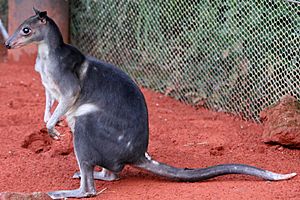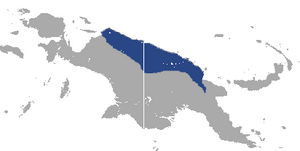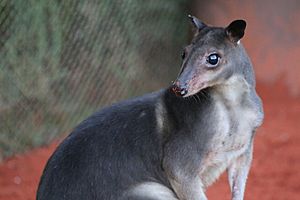White-striped dorcopsis facts for kids
Quick facts for kids White-striped dorcopsis |
|
|---|---|
 |
|
| White-striped dorcopsis in Pairi Daiza | |
| Conservation status | |
| Scientific classification | |
| Genus: |
Dorcopsis
|
| Species: |
hageni
|
 |
|
| White-striped dorcopsis range | |
The white-striped dorcopsis, also known as the greater forest wallaby, is a cool animal that lives in the forests of New Guinea. It is a type of marsupial, which means it carries its babies in a pouch, just like a kangaroo or a wallaby! This animal belongs to the same family as kangaroos, called Macropodidae.
You can find the white-striped dorcopsis in the northern parts of West Papua in Indonesia, and also in Papua New Guinea. It likes to live in tropical forests. Scientists say it is a "Least concern" species, which means it is not currently in danger of disappearing.
Contents
Where the White-striped Dorcopsis Lives
The white-striped dorcopsis is special because it only lives on the island of New Guinea. Its home covers a big part of northern West Papua and Papua New Guinea. However, you won't find it on the Huon Peninsula.
These animals usually live in places that are not too high up, generally below 400 meters (about 1,300 feet) above sea level. They are quite adaptable and can live in both untouched forests and forests that have been changed a bit by people.
- In the northern areas, they often live near alluvial fans, which are fan-shaped areas of land made by rivers, close to the Sepik floodplains.
- In the southern parts, they prefer mixed forests near rivers, but they don't usually go into the lower parts of hill forests.
What the White-striped Dorcopsis Eats
The white-striped dorcopsis is a herbivore, meaning it eats plants. It mostly eats leaves and other plant parts, like a browser. But sometimes, during the day, people have seen it turning over flat stones. It does this to look for insects and other small creatures to eat!
It also enjoys eating fungi, which are like mushrooms. By eating fungi, the dorcopsis helps spread their spores around the forest. This is important because these spores help create healthy mycorrhizal communities, which are special partnerships between fungi and plant roots that help trees grow.
White-striped Dorcopsis Babies
Scientists have found baby white-striped dorcopsis in the pouches of their mothers. These babies are born without fur and are very tiny. They have been seen in pouches during January and April, which tells us a bit about when they have their young.
How We Protect the White-striped Dorcopsis
The white-striped dorcopsis lives in a large area of northern New Guinea. It is quite common in places where the habitat is suitable for it. Since it can live in different types of forests, including those that have been slightly changed, it's pretty resilient.
Some of these animals live in protected areas, which helps keep them safe. While some people do hunt them for food, this doesn't seem to be a major threat to the species as a whole. Because there are many of them, and their numbers seem stable, the International Union for Conservation of Nature (IUCN) has listed them as "Least concern". This means they are not currently at high risk of extinction.
See also
 In Spanish: Gran walabi del bosque para niños
In Spanish: Gran walabi del bosque para niños



